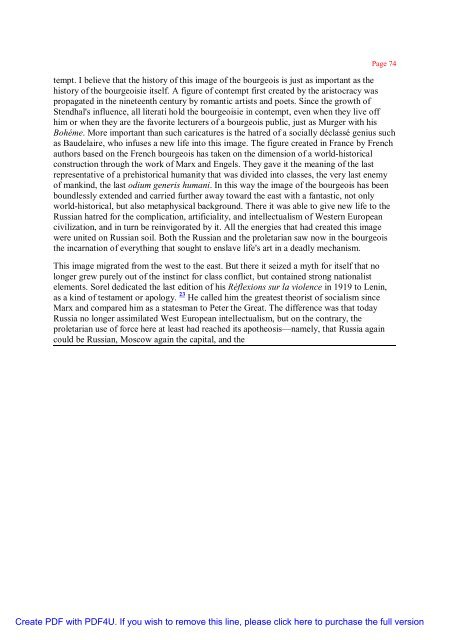131214840-Carl-Schmitt
131214840-Carl-Schmitt
131214840-Carl-Schmitt
- No tags were found...
You also want an ePaper? Increase the reach of your titles
YUMPU automatically turns print PDFs into web optimized ePapers that Google loves.
Page 74<br />
tempt. I believe that the history of this image of the bourgeois is just as important as the<br />
history of the bourgeoisie itself. A figure of contempt first created by the aristocracy was<br />
propagated in the nineteenth century by romantic artists and poets. Since the growth of<br />
Stendhal's influence, all literati hold the bourgeoisie in contempt, even when they live off<br />
him or when they are the favorite lecturers of a bourgeois public, just as Murger with his<br />
Bohéme. More important than such caricatures is the hatred of a socially déclassé genius such<br />
as Baudelaire, who infuses a new life into this image. The figure created in France by French<br />
authors based on the French bourgeois has taken on the dimension of a world-historical<br />
construction through the work of Marx and Engels. They gave it the meaning of the last<br />
representative of a prehistorical humanity that was divided into classes, the very last enemy<br />
of mankind, the last odium generis humani. In this way the image of the bourgeois has been<br />
boundlessly extended and carried further away toward the east with a fantastic, not only<br />
world-historical, but also metaphysical background. There it was able to give new life to the<br />
Russian hatred for the complication, artificiality, and intellectualism of Western European<br />
civilization, and in turn be reinvigorated by it. All the energies that had created this image<br />
were united on Russian soil. Both the Russian and the proletarian saw now in the bourgeois<br />
the incarnation of everything that sought to enslave life's art in a deadly mechanism.<br />
This image migrated from the west to the east. But there it seized a myth for itself that no<br />
longer grew purely out of the instinct for class conflict, but contained strong nationalist<br />
elements. Sorel dedicated the last edition of his Réflexions sur la violence in 1919 to Lenin,<br />
as a kind of testament or apology. 23 He called him the greatest theorist of socialism since<br />
Marx and compared him as a statesman to Peter the Great. The difference was that today<br />
Russia no longer assimilated West European intellectualism, but on the contrary, the<br />
proletarian use of force here at least had reached its apotheosis—namely, that Russia again<br />
could be Russian, Moscow again the capital, and the<br />
Create PDF with PDF4U. If you wish to remove this line, please click here to purchase the full version


